
Les Frères Voisin
Gabriel (1880 - 1973) et Charles (1882 - 1912)
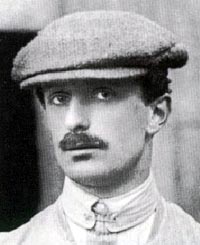
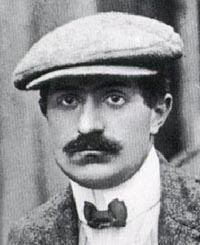
Gabriel and Charles Voisin
Gabriel (Belleville/Saùne 1880 Ozenay 1973)
Charles (Lyon 1882 - Corcelles 1912)
Collection Roger-Viollet, photo H. Manuel Nouvelle Histoire Mondiale de l'Aviation, Edmond Petit
Text and images so marked and or linked Copyright © 2000 NASMSI are used with permission from the National Air and Space Museum Smithsonian Institution
Gabriel and Charles Voisin were among Europe's leading pioneer aviators. Gabriel began his formal aviation career in 1903 when he was engaged by a prominent French aeronautical promoter, Ernest Archdeacon, to build gliders for him.
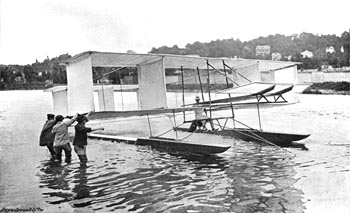
Voisin-Archdeacon Hydroplane Glider, 1905
Le 8 juin 1905, au-dessus de la Seine, Gabriel Voisin réussit sur un planeur construit avec Ernest Archdeacon à voler à 15 m de haut sur 150 m.
Download a 1000pixel image
In 1905 Gabriel formed the first commercial aircraft manufacturing company in Europe with the soon-to-be famous Louis Blériot. Numerous disputes between the two quickly arose, however, and Voisin bought out Blériot's interest in the venture in 1906.
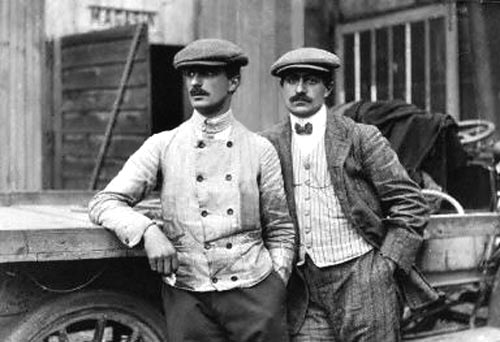
Gabriel and Charles Voisin, 1906
Gabriel immediately reformed the company with his brother Charles, thus establishing the highly successful Appareils d'Aviation Les Frères Voisin. The firm's first truly successful airplane appeared in 1907. The classic Voisin pusher biplane design of 1907 was one of the most significant aircraft of the pre-World War I era. Many of Europe's leading aviators flew the Voisin.
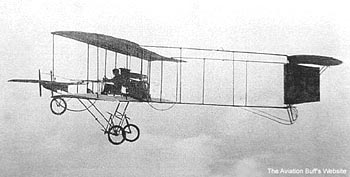
Voisin Racer, 1909
Download a 750pixel image
On January 13, 1908, Henri Farman made the first one-kilometer circuit in Europe with a Voisin biplane, winning a 50,000-franc prize and much acclaim for the Voisin product. By 1912, Les Frères Voisin had produced more than 75 airplanes that were based on the simple and sturdy 1907 design.
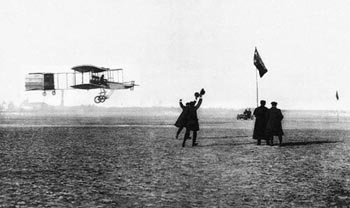
Henri Farman flies the first one-kilometer circuit, January 13, 1908
http://members.home.net
Voisin Factory
Rue de la Ferme; Billancourt, Paris, France
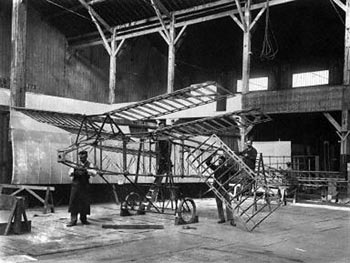
The Voisin Factory, 1908
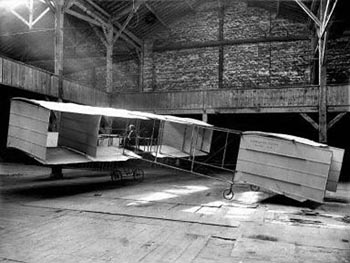
The Voisin Factory, 1908
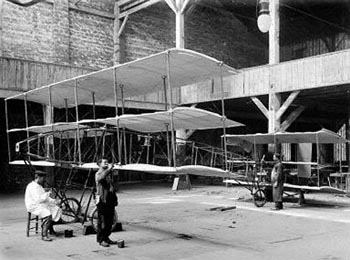
The Voisin Factory, 1908
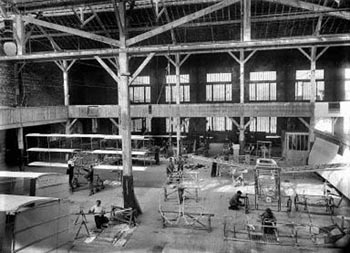
The Voisin Factory, 1908
The Voisin Military Pusher Biplane 1912 - 1918 : Overview
Copyright © 2000 NASMSI, http://www.csd.uwo.ca
In 1912, the Voisin brothers developed a version of their successful design for the military. Thereafter Compagnie Gabriel Voisin built aircraft almost exclusively for military contracts. The Voisin 1912 Type, as it was referred to by the French military, also sometimes identified as the Voisin Type 1, launched the standard configuration of almost all Voisin aircraft throughout the war. Designated the Type L by the Voisin factory, this seminal airplane was an equal-span biplane with no dihedral, with a short streamlined nacelle carrying the crew of two in front and an 80-horsepower Le Rhône 9C engine at the rear.
A cruciform tail was attached to the wings with a set of booms, and it had a quadricycle landing gear. A second pre-war military design, similar to the Type L, powered by a 70-horsepower Gnome 7A engine, was produced in 1913. Although they were largely obsolete by the start of the war, the sturdiness and the reliability of these, and subsequent, Voisin aircraft (models 1-10 Ed.) enabled them to form the backbone of the French night bomber force until late in 1918. Over 3500 were built
Les Frères Voisin was conservative in its design philosophy. There were only slight, incremental design changes in the airframes during the war. Improvement in performance of the successive types was made principally by installing more powerful engines, usually necessitating wings of greater span. The first wartime version, the Voisin 3, powered by a 120-horsepower Salmson M9 engine, had a range of 200 km (125 mi), carrying a bomb load of 150 kg (330 lb). The 1918 Voisin 10 by comparison, which in outward appearance looked much like the Voisin 3, had a range of 350 km (220 mi) with a bomb load of 300 kg (660). The 280-horsepower Renault 12Fe engine of the Voisin 10 gave it a maximum speed of 135 kph (84 mph) at 2,000 m (6,562 ft) altitude, 37 kph (23 mph) faster than the Voisin Type 3 at the same altitude.
During the war, the Voisin pusher series performed a variety of missions, including reconnaissance, artillery spotting, training, day and night bombing, and ground attack. The first recorded armed aerial victory of the war occurred on October 5, 1914, when a French pilot and his observer, flying a Voisin 3, downed a German Aviatik B.1 with bullets fired from a Hotchkiss machine gun.
The Voisin Type 3 is also notable in having equipped the first dedicated bomber units. Voisin Type 3 units staged a retaliatory attack against the Badische Anilin Gesellschaft at Ludwigshaven, Germany, on May 26, 1915, shortly after the German Army introduced poison gas in battle. Successful daytime attacks on targets within Germany ensued, but by 1916 the Voisin Type 3 and its immediate successors became vulnerable to new, better performing, German fighters. (The Voisin Type 4 was similar to the Type 3, but was fitted with a 47 mm cannon and used primarily for ground strafing. The Types 5 and 6 were virtually the same as the Type 3, except that they had more powerful Salmson engines.)
The Voisins were slow and with their pusher configuration they were defenseless from the rear. Despite these limitations, these rugged and reliable aircraft still had a role to play. Voisins were used as trainers and for night missions for the remainder of the war. Voisin pusher aircraft were supplied to, or built under license by, twelve countries, including Britain, Russia, Italy, and the United States.
The Voisin Military Pusher Biplane 1912 - 1918 : Machine by Machine Analysis
Voisin Type 1
http://www.csd.uwo.ca, http://members.home.net
The Voisin Type 1 but also known as the Voisin 1912 Type or Voisin Type L, was the first aircraft to shoot down another aircraft, a German Aviatik biplane on 5 October 1914, but they were mostly used as bombers. The machine gun of the Voisin I was replaced by 37mm or 47mm cannon in later versions.
It was also known as the 'Chicken Coop' because of its profusion of struts and wires. It was powered by an 80-horsepower engine and could carry 130 pounds (58 kilograms) of bombs to be hand dropped overboard by the machine gunner/bombardier.
Voisin Type 1, Profile
Voisin Type 1, 3View
Voisin Type 1, Statistics
Voisin Type 1, Images
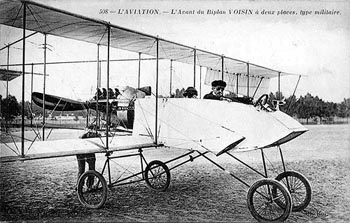
Voisin Type 1
download a 1000pixel image
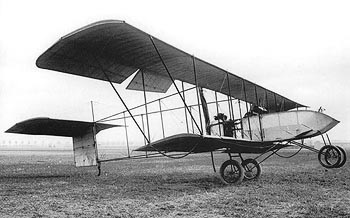
Voisin Type 1
download a 750pixel or 1500pixel image
Voisin Type 2
Note: The Type 2 has proved elusive to research. The editor suspects that, like Types 4 and 6, the Type 2 was simply an upgrade to the previous model (in this case the Type 1), either by way of a more powerful motor or armament
Voisin Type 3
Copyright © 2000 NASMSI, http://www.csd.uwo.ca
The Voisin Type 3, was the first wartime version, powered by a 120-horsepower Salmson M9 engine, had a range of 200 km (125 mi), carrying a bomb load of 150 kg (330 lb). The Voisin Type 3 is also notable in having equipped the first dedicated bomber units. Voisin Type 3 units staged a retaliatory attack against the Badische Anilin Gesellschaft at Ludwigshaven, Germany, on May 26, 1915, shortly after the German Army introduced poison gas in battle. Successful daytime attacks on targets within Germany ensued, but by 1916 the Voisin Type 3 and its immediate successors became vulnerable to new, better performing, German fighters.
[ Note that with Type 3 and 5 there are conflicting naming references to the (1) Type #, (2) Type L, (3) Type# LA and (4) Type #LAS. The data presented here comes from the individual sources and will be further researched to present a more accurate table of machine order and nomenclature. It is known for example that the S stood for surélevé (raised) which indicated the use of a raised engine mount. More to come - Ed. Feb.02]
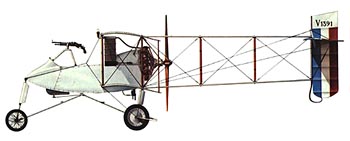
Voisin Type 3, Profile
http://ailesfrance.multimania.com
download a 750pixel image
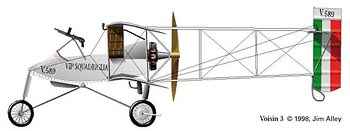
Voisin Type 3, Profile
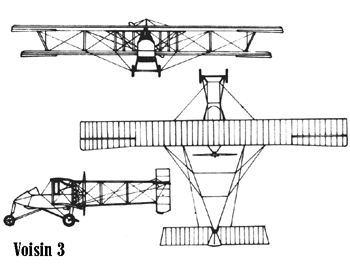
Voisin Type 3, 3View
http://www.xkalibor.com
Voisin Type 3, Statistics
http://www.xkalibor.com
Nation : France
Manufacturer : Compagnie Gabriel Voisin
Type : Light Bomber
Year : 1914
Engine : Renault 8-cylinder air-cooled inline V, 100 hp
Wingspan : 53' (16.15 m)
Length : 30' 8" (9.45 m)
Height : 10' 5" (3.18 m)
Weight (Empty) :
Weight (Gross) : 2,045 lbs. (928 kg)
Speed : 66 mph (106 km/h) at sea level
Ceiling : 12,467 ft.
Endurance : 3 hrs. 45 min.
Range :
Armament : 1 machine gun 288 lbs. (130 kg) of bombs
Crew: 2
Voisin Type 3, Images
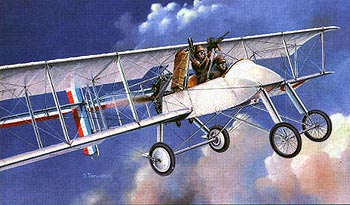
Voisin Type 3, Kitset by Flashback (1/72 scale)
http://www.czechia.com
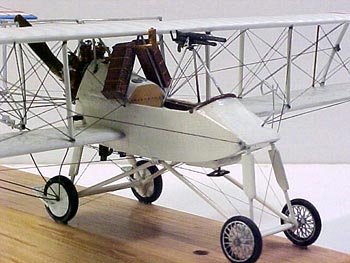
Voisin Type 3, Kitset by Flashback (1/72 scale)
The image is from a Russian site that strangely does not seem to bear the name of the modelbuilder
http://www.ipclub.ru
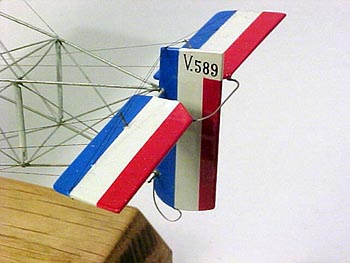
Voisin Type 3, Kitset by Flashback (1/72 scale)
The image is from a Russian site that strangely does not seem to bear the name of the modelbuilder
http://www.ipclub.ru
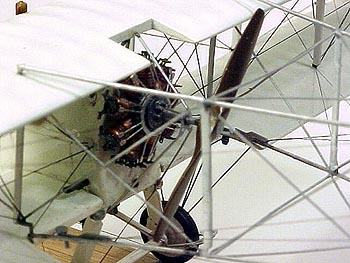
Voisin Type 3, Kitset by Flashback (1/72 scale)
The image is from a Russian site that strangely does not seem to bear the name of the modelbuilder
http://www.ipclub.ru

Voisin Type 3
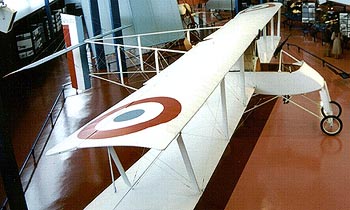
Voisin Type 3
download a 750pixel image
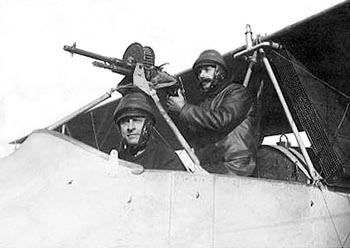
Voisin Type 3, cockpit detail
Voisin Type 3 LAS
[ Note that with Type 3 and 5 there are conflicting naming references to the (1) Type #, (2) Type L, (3) Type# LA and (4) Type #LAS. The data presented here comes from the individual sources and will be further researched tp present a more accurate table of machine order and nomenclature. It is known for example that the S stood for surélevé (raised) which indicated the use of a raised engine mount. More to come - Ed. Feb.02]
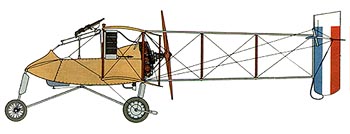
Voisin Type 3 LAS, Profile
http://ailesfrance.multimania.com
download a 750pixel image
Voisin Type 3 LAS, 3View
Voisin Type 3 LAS, Statistics
http://ailesfrance.multimania.com
Voisin Type 3 LAS, Images
Voisin Type 4
Voisin Type 4, Profile
Voisin Type 4, 3View
Voisin Type 4, Statistics
http://ailesfrance.multimania.com
Voisin Type 4, Images
Voisin Type 5, also known as the 'Voisin 150hp'
http://209.235.66.44
The Voisin Type 3 had proved a successful bomber, but its payload was limited by the Salmson M9 engine, which produced only 120-hp. The Aviation Militaire wished to obtain a more powerful airplane but with the concours puissant (competition for a heavy bomber) not due to take place until mid-1915, it was decided to produce a Voisin Type 3 with a new engine.
A Voisin Type 3 airframe was fitted with a 150-hp Salmson P9 engine, and the airframe was strengthened and the central nacelle streamlined. The new engine was placed on a raised platform to provide clearance for the propeller and was angled to provide downward thrust. The landing gear was strengthened and the wing chord was increased from the roots to the wing tips.
The new aircraft was given the STAé designation Voisin Type 5, while the factory designation was LAS. The S stood for surélevé (raised) which indicated the raised engine mount. While the exhaust system on the Voisin Type 3 permitted fumes to escape freely, that of the Voisin Type 5 ejected the fumes upward through two exhaust pipes.
One Voisin Type 5 was transformed into a twin-engine aircraft in 1916. This was accomplished by adding a second Salmson in the front of the fuselage driving a tractor propeller. it is believed this was done to test a possible configuration for a new bomber planned by Voisin. The twin-engine Voisin Type 5 first flew in early 1916; apparently the type was not developed further.
The first Voisin Type 5 reached VB 101 in 1915 and soon replaced the Voisin Type 3 on the production lines. However, the Voisins 150hp (as they were referred to at the front) were held in low regard by their crews. Despite the more powerful engine, the Voisin Type 5s' payload was only marginally better and the maximum speed was only 13 km/h faster. Approximately 300 Voisin Type 5s were built, and these served alongside the Voisin Type 3s in front-line escadrilles during 1915 and well into 1916.
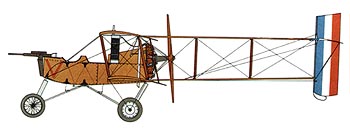
Voisin Type 5, Profile
http://ailesfrance.multimania.com
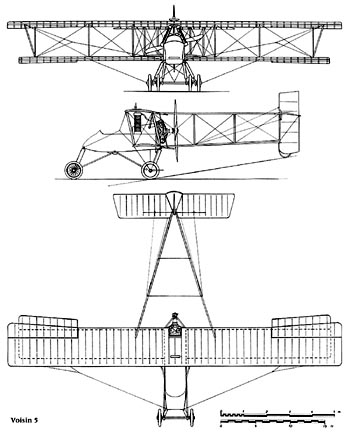
Voisin Type 5, 3View
http://www.pilots-n-planes-ww1.com
download a 1000 pixel JPG image or 1000 pixel GIF
Voisin Type 5, Statistics
http://www.xkalibor.com
Nation : France
Manufacturer : Compagnie Gabriel Voisin
Type : Light Bomber
Entered Combat : 1915
Engine : Salmson (Canton-Unne) 9-cyl. liquid-cooled radial, 150 hp
Wingspan : 48' 4.75" (14.75 m)
Length : 31' 3.25" (9.53 m)
Height : 11' 11" (3.63 m)
Weight (Empty) :
Weight (Gross) : 2,516 lbs. (1,140 kg)
Speed : 65 mph (105 km/h)
Ceiling : 11,485 ft. (3,500 m)
Endurance : 3 hrs. 30 mins.
Range :
Armament : 1 machine gun or 37 mm cannon
Crew : 2
Voisin Type 5, Images
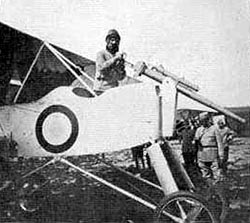
Voisin Type 5, 'Avion Cannon', 37mm cannon
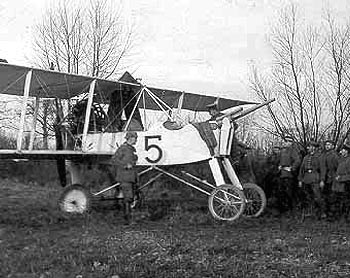
Voisin Type 5, 'Avion Cannon', 37mm cannon
Voisin Type 6
Note: As with the Type 5, the Type 6 was a Voisin Type 3 airframe, fitted with an even more powerful [155hp] Salmson engine. [Smithsonian]
Voisin Type 7
Note: The Type 7 was a transitional model of which only about a hundred were built. [Smithsonian]
Voisin Type 8
Copyright © 2000 NASMSI
The Voisin Type 8 entered service with French night bombing squadrons in November 1916. (The Type 7 was a transitional model of which only about a hundred were built.) The Type 8 was intended to be powered by a 300-horsepower Hispano-Suiza engine, nearly double the output of the 155-horsepower Salmson used on the Type 6. But the Hispanso-Suizas were not available in sufficient numbers, and a 220-horsepower Peugeot 8 Aa inline was substituted. To accommodate the bulkier and heavier Peugeot, the Type 8 required an enlarged and strengthened fuselage, and greater wingspan. It was fitted with either a single machine gun or a 37 mm cannon.
The new engine provided a nominal increase in performance over the Voisin Type 6 while carrying the same bomb load of 180 kg (396 lb); but it was unreliable. Voisin then developed the Type 10, which combined a lighter and more powerful 280-horsepower Renault 12Fe engine with the Type 8 airframe. The Type 10, with improved range, speed, and bomb load, replaced the Voisin Type 8 early in 1918. (Only one Type 9 was built. It was a modified Type 8 with 160-horsepower 8G engine intended for reconnaissance.)
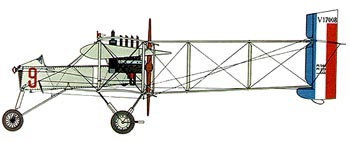
Voisin Type 8, Profile
http://ailesfrance.multimania.com
download a 750pixel image
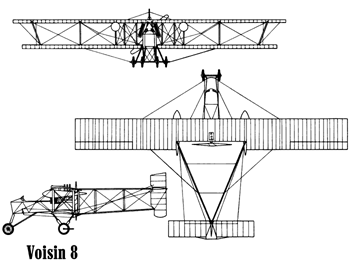
Voisin Type 8, 3View
http://www.xkalibor.com
Voisin Type 8, Statistics
http://www.xkalibor.com
Nation : France
Manufacturer : Compagnie Gabriel Voisin
Type : Bomber
Entered Combat : 1916
Engine : Peugeot 8-cyl. liquid-cooled inline, 220 hp
Wingspan : 61' 8" (18.2 m)
Length : 36' 2" (11.02 m)
Height : 11' 5.57" (3.5 m)
Weight (Empty) :
Weight (Gross) : 4,100 lbs. (1,860 kg)
Speed : 82 mph (132 km/h)
Ceiling : 14,110 ft. (4,300 m)
Endurance : 4 hrs.
Range :
Armament: 1-2 machine guns & 397 lbs. (180 kg) of bombs
Crew : 2
Voisin Type 8, Images
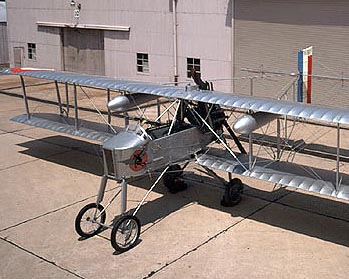
Voisin Type 8
Copyright © 2000 NASMSI
download a 750pixel image
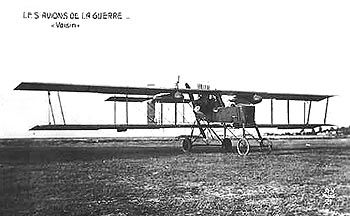
Voisin Type 8
http://members.home.net
Voisin Type 9
Note : Only one Type 9 was built. It was a modified Type 8 with 160-horsepower 8G engine and intended for reconnaissance. [Smithsonian]
Voisin Type 10
Voisin Type 10, Profile
Voisin Type 10, 3View
Voisin Type 10, Statistics
http://ailesfrance.multimania.com
Voisin Type 10, Images
Voisin Triplane, 1915
Voisin Triplane, 1915, Profile
Voisin Triplane, 1915, 3View
Voisin Triplane, 1915, Statistics
Voisin Triplane 1915, Images
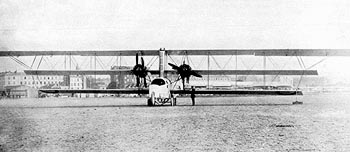
Voisin Triplane, 1915
http://www.pilots-n-planes-ww1.com
Download a 1000pixel image
Voisin Triplane, 1916
Voisin Triplane, 1916, Profile
Voisin Triplane, 1916, 3View
Voisin Triplane, 1916, Statistics
Voisin Triplane, 1916, Images
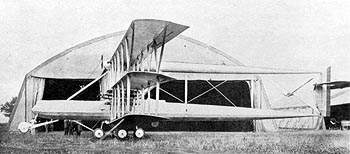
Voisin Triplane, 1916
Download a 1000pixel image
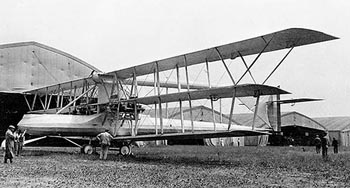
Voisin Triplane, 1916
Download a 1000pixel image
Further Reading
Index of /ww1fighters/planes/france/stats
http://xkalibor.com
Index of /ww1fighters/planes/france/stats/images
http://xkalibor.com
Images : Voisin Military Pusher Biplane
http://digilander.iol.it
ww1.org : Voisin
http://www.ww1.org.uk
Avions Voisin
http://www.cjbalm.com
In 1904 after expressing an interest in flight, the French architecture student Gabriel Voisin was hired by Ernest Archdeacon to pilot a Wright type glider that he was testing. In 1905 they formed the Syndicat d'Aviation with the intention of building aircraft. They built two gliders one of which was for Louis Bleriot. Later that year he joined Bleriot and started the Bleriot-Voisin Company.
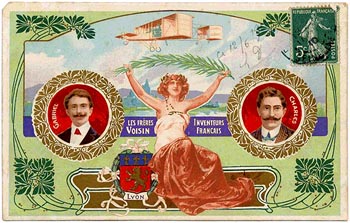
Les Frères Voisin, Inventeurs Francais
Download a 1000pixel image
As well as working with Bleriot, Voisin also helped Alberto Santos-Dumont build the aeroplane "14bis" which Santos-Dumont successfully flew in 1906, being the first controlled, powered flight in Europe. After this event the partnership with Bleriot broke up. Voisin retained the factory and invited his brother, Charles to join him, forming "Voisin Frères" which became the world's first commercial aircraft manufacturer.
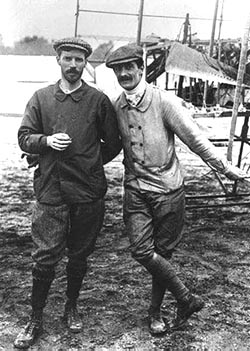
Henri Farman and Gabriel Voisin, c.1909
Download a 500pixel image
They built an aeroplane for Henry Kpferer and then one for Léon Delegrange in which Gabriel Voisin achieved flight in 1907. They then built an aeroplane for Henry Farman which was the first to fly a kilometre circuit. Voisin then built another for Farman, but instead sold it to Moore-Brabazon. This infuriated Farman so much that he established his own company to compete with Voisin.
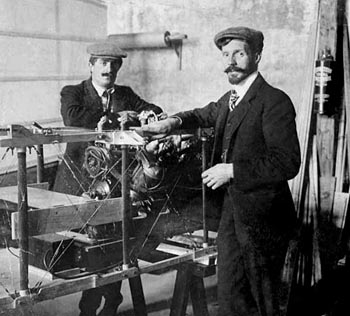
Charles Voisin and Henri Farman, 1907
Download the uncropped original image
In 1912 Charles Voisin was killed in a car crash, but Gabriel continued with the business, building bombers throughout W.W.I. After the war, when orders dried up, Voisin designed and built the world's first prefabricated houses. In 1919 he turned his attentions to Automobiles producing luxury cars which were amongst the most advanced in the world. During W.W.II. the German owned company, Gnome et Rhône took-over Voisin's factory but required him to remain to supervise.
Editors Note : August 7, 2002
I have recently received an eMail regarding this last papagraph taken from the site http://www.cjbalm.com
Charles Thayer writes...
"...you describe the company (Gnome et Rhône) as German owned. As far as I know Gnome was started by the Seguin brothers in France in 1895 then bought Le Rhône in 1915. In 1922 a French banker Paul-Louis Weiller succeeded the Seguin brothers..."
any comments correcting or embellishing work on this site are warmly welcomed. The aim of this site is always to present the most accurate data possible. [- Ed.]
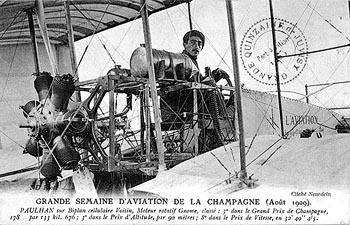
Louis Paulhan, Rheims (Reims), Voisin construction detail
Download a 1000pixel image
After the war he was accused of collaboration with the Nazi's and the French government siezed the opportunity to take-over his company. He was later exonerated, but came close to bankruptcy. Voisin died in 1973 at the age of 93.
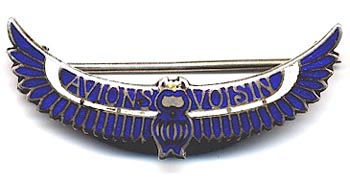
Scarce and beautiful lapel badge (pin) made for the aircraft and luxury car manufacturer "Avions Voisin" (Voisin Aircraft)
This original badge (38mm) is made in sterling silver and enamel and is in the form of the Voisin logo (a winged scarab) and bears the inscription, "Avions Voisin". The badge is mounded on a pin fastener and it's reverse is stamped, "sterling".
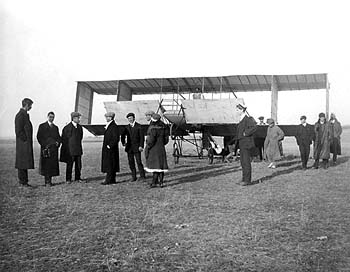
Harry Houdini (third from left), Sydney, Australia, 1910
You may wish to download a 500 pixel or 1000 pixel version of this image
In 1910 the famous escapologist 'Harry Houdini' arrived in Australia with his own recently purchased Voisin. Indeed within weeks Houdini was to become the first person (by one day) to fly a heavier than air craft in Australia. This story is told in some detail elsewhere on this site and includes both photographs and video of Houdini and his Voisin in Sydney.
A History of Aeronautics
by E. Charles Vivian
http://www.bookrags.com
Part II - 1903-1920 : Progress in Design, I
By Lieut.-Col. W. Lockwood Marsh
I. The Beginnings
The other chief French experimenters at this period were the Voisin Frères, whose first two machines--identical in form--were sold to Delagrange and H. Farman, which has sometimes caused confusion, the two purchasers being credited with the design they bought. The Voisins, like the Wrights, based their designs largely on the experimental work of Lilienthal, Langley, Chanute, and others, though they also carried out tests on the lifting properties of aerofoils in a wind tunnel of their own. Their first machines, like those of Santos-Dumont, showed the effects of experimenting with box-kites, some of which they had built for M. Ernest Archdeacon in 1904.
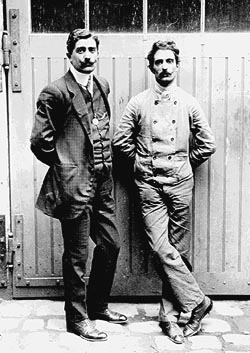
Gabriel and Charles Voisin, c.1909
In their case the machine, which was again a biplane, had, like both the others previously mentioned, an elevator in front--though in this case of monoplane form--and, as in the Wright, a rudder was fitted in rear of the main planes. The Voisins, however, fitted a fixed biplane horizontal 'tail'--in an effort to obtain a measure of automatic longitudinal stability--between the two surfaces of which the single rudder worked. For lateral stability they depended entirely on end curtains between the upper and lower surfaces of both the main planes and biplane tail surfaces.
They, like Santos-Dumont, fitted a wheeled undercarriage, so that the machine was self-contained. The Voisin machine, then, was intended to be automatically stable in both senses; whereas the Wrights deliberately produced a machine which was entirely dependent upon the pilot's skill for its stability. The dimensions of the Voisin may be given for comparative purposes, and were as follows: Span 33 feet with a chord (width from back to front) of main planes of 6 1/2 feet, giving a total area of 430 square feet.
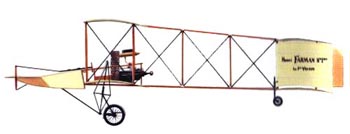
Farman's Voisin, 1908
The 50 horse-power Antoinette engine, which was enclosed in the body (or 'nacelle ') in the front of which the pilot sat, drove a propeller behind, revolving between the outriggers carrying the tail. The total weight, including Farman as pilot, is given as 1,540 lbs., so that the machine was much heavier than either of the others; the weight per horse-power being midway between the Santos-Dumont and the Wright at 31 lbs. per square foot, while the wing loading was considerably greater than either at 3 1/2 lbs. per square foot.
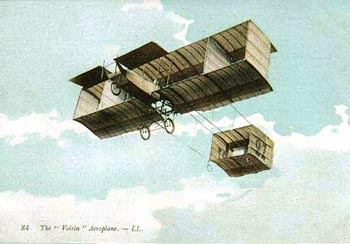
The 'Classic' Voisin c.1909
Contemporary hand tinted postcard by 'Tuck'
The Voisin machine was experimented with by Farman and Delagrange from about June 1907 onwards, and was in the subsequent years developed by Farman; and right up to the commencement of the War upheld the principles of the box-kite method of construction for training purposes. The chief modification of the original design was the addition of flaps (or ailerons) at the rear extremities of the main planes to give lateral control, in a manner analogous to the wing-warping method invented by the Wrights, as a result of which the end curtains between the planes were abolished.
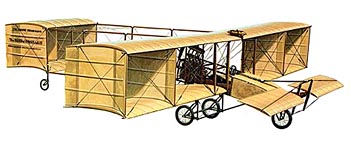
Voisin's 'Bird of Passage', 1909
Download a 750pixel image
An additional elevator was fitted at the rear of the fixed biplane tail, which eventually led to the discarding of the front elevator altogether. During the same period the Wright machine came into line with the others by the fitting of a wheeled undercarriage integral with the machine. A fixed horizontal tail was also added to the rear rudder, to which a movable elevator was later attached; and, finally, the front elevator was done away with.
It will thus be seen that having started from the very different standpoints of automatic stability and complete control by the pilot, the Voisin (as developed in the Farman) and Wright machines, through gradual evolution finally resulted in aeroplanes of similar characteristics embodying a modicum of both features.
continues...
XII. The First Years of Conquest
http://www.bookrags.com
Meanwhile, the Voisin Brothers, who in 1904 made cellular kites for Archdeacon to test by towing on the Seine from a motor launch, obtained data for the construction of the aeroplane which Delagrange and Henry Farman were to use later. The Voisin was a biplane, constructed with due regard to the designs of Langley, Lilienthal, and other earlier experimenters--both the Voisins and M. Colliex, their engineer, studied Lilienthal pretty exhaustively in getting out their design, though their own researches were very thorough as well.
The weight of this Voisin biplane was about 1,450 lbs., and its maximum speed was some 38 to 40 miles per hour, the total supporting surface being about 535 square feet. It differed from the Wright design in the possession of a tail-piece, a characteristic which marked all the French school of early design as in opposition to the American. The Wright machine got its longitudinal stability by means of the main planes and the elevating planes, while the Voisin type added a third factor of stability in its sailplanes.
Further, the Voisins fitted their biplane with a wheeled undercarriage, while the Wright machine, being fitted only with runners, demanded a launching rail for starting. Whether a machine should be tailless or tailed was for some long time matter for acute controversy, which in the end was settled by the fitting of a tail to the Wright machines-France won the dispute by the concession.
A Turn for the Purse
http://www.first-to-fly.com
The French were in the air and in the news in the spring of 1908. Gabriel Voisin was manufacturing airplanes made to order. He had formed a brief partnership with Louis Bleriot and built two airplanes with him - a biplane glider and a powered biplane. The glider flew poorly and the powered version didn't fly at all, which Voisin blamed on Bleriot's unusual ideas and his erratic approach to aeronautical engineering. Bleriot would try anything, sometimes making drastic changes to the aircraft such as substituting elliptical wings for conventional wings.
So Voisin left Bleriot to his own devices and teamed up with his brother Charles. They established the first airplane factory in the world at Billancourt, France, making any design that a customer wanted. A Russian prince ordered a craft with a propeller in the shape of a spiral staircase. A Dutchman paid for a set of wings grafted onto a "kind of car" - it failed to fly. But their most successful aircraft were those they designed themselves. Earlier, they had made a float-glider for Archdeacon with biplane wings and an elevator in front, similar to the standard Wright configuration. But they had added a box-kite tail and side curtains between the wings. The craft, which was in fact a giant box kite with an elevator and a rudder, flew reasonably well.
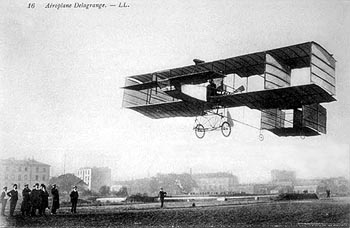
Voisin-Delagrange I
Download a 750pixel image
In 1907, they made a similar airplane for Ferdinand Leon Delagrange, mounting a 50-horsepower Antionette engine and a propeller on the lower wing to push it through the air. Although it had no roll control, Delagrange was able to make short hops of up to 500 meters (1650 feet). As such, the Voisin-Delagrange I was the first European airplane to best the Wright's first powered flights in 1903.
Later on that year, Henri Farman found his way to the Voisin aircraft plant. Farman was the son of a prominent journalist who had been bitten by the aviation bug. He first took to the air in a home-built Chanuet-Herring glider, then sought out the Voisin brothers for something with power. Farman carefully looked over the plans Gabriel and Charles laid before him, then ordered a Voisin aircraft with a few minor - but important - modifications.
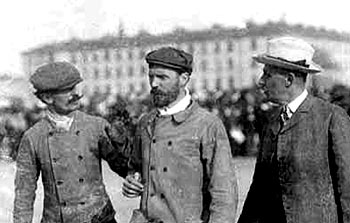
Gabriel Voisin, Henri Farman and Count Henri de la Vaulx
Download a 350pixel or 750pixel version of the original image
Farman began to fly the Voisin-Farman I on September 30, 1907, making a modest hop of just 30 meters (100 feet). Thereafter, he began to stretch the distance little by little. He also modified the airplane as he gained more flying experience, eliminating the side curtains, reducing the size of the tail, and adjusting the dihedral angle of the wings, all to reduce drag, improve stability, and make the airplane more maneuverable. However, even in its final form, it had no roll control - Farman made do with an elevator and rudder only.
On October 26, 1907, Farman made a flight of 712 meters (2,350 feet) and won a second Archdeacon Cup. This was a prize that Ernest Archdeacon had offered to the aviator who made the longest flight duringthe year. On November 19, 1907, Farman made a run at the Grand Prix de Aviation, but didn't quite complete the circular course. Orville Wright, who was still in Europe, witnessed Farman's flight. When asked by the reporters for a comment on the rapid progress of French aviation, he was cool and criticized the French airplane's control system obliquely.
"Time will show whether the methods of control used in the Farman machine are adequate to meet the conditions encountered in windy weather," he was quoted. Privately, he wrote to Chanute that the French were busy but "we see no indication of a practical machine in the near future."
Archdeacon, ever the Wright detractor, took affront at Orville's attitude.
"The famous Wright brothers may claim all they wish," he blustered. "If it were true - and I doubt it more and more - that they were the first to fly through the air, they will not have the glory. The first authentic experiments in powered aviation have taken place in France; they will progress in France; and the Wrights will, I am sure, be beaten by us as well before they will have decided to show their phantom machine."
On January 13, 1908, Farman took off again in pursuit of the Grand Prix de Aviation and its 50,000 franc purse. He made a flying start, crossing the starting poles about 4 meters or 13 feet off the ground. He flew straight out for about 500 meters, slowly climbing to 12 meters or 40 feet, then made a wide, flat turn, using rudder alone to slide around the marker. He came back and made another turn, crossed the point at which he started, and landed gently. The entire flight lasted 28 seconds, and covered the prescribed kilometer. It didn't matter that his turns were clumsy and he was in constant danger of losing control of the Voisin-Farman I. Henri Farman had won the most coveted prize in aviation, and for the moment - as far as the French were concerned - the Wright brothers were beaten.
The Voisin Canard and Hydro Canard
http://w1.871.telia.com
In 1910 the Voisin company needed a replacement for their famous, but now obsolete, boxkite-like standard construction. The "box-kite" was modernized, fitted with ailerons and a simplified tail-unit, and the front elevator was discarded. This model then became the direct progenitor of the Voisin WW1 bombers. But aside of this evolution, one also experimented with totally new types. One of these, which was to become quite successful, was the Voisin Canard.
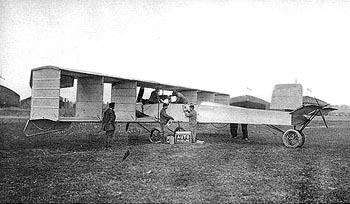
Voisin Canard
http://members.home.net
Download a 750pixel image
The first of these planes was tested in late 1910, and it had been put together from existing parts, the fuselage reportedly coming from an old triplane. The wingspan was 36', and it was powered by a 50 hp Rossel-Peugeot rotary engine. A 3-view of this machine is found in The Aero, 11 Jan. 1911. It does however appear to be rather inaccurate (not an unknown problem with early scale drawings) when compared with photos of (presumably) the same plane.
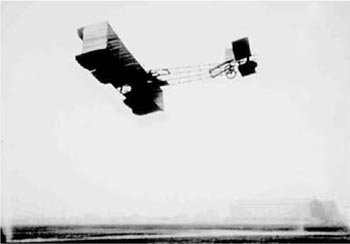
Voisin Canard
http://members.home.net
Download a 750pixel image
The fuselage was uncovered, and the wings were set with some dihedral. In common with other landplane Voisin Canards the nose wheels are put directly under the fuselage, so when at rest it assumes a very strange looking nose down attitude.
Other Canards followed, now with covered fuselages and wings without dihedral. Instead the wings were provided with side panels, as in the early boxkite Voisins. In The Areo, July 1911, is found a 3-view of a two-seat landplane of this type.
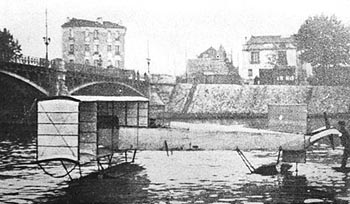
Voisin Hydro Canard 1, 1911
http://w1.871.telia.com
In 1911, seaplanes were a novelty which attracted much attention, and it was decided to put floats on the Canard. This resulted in the Voisin Hydro Canard I, shown in the photo above. It was flown by Maurice Colliex from the Seine near Billancourt. In August 1911, one had fitted a Canard with both wheels and floats, and Colliex made a flight from Issy to the Seine and back, which got some attention.
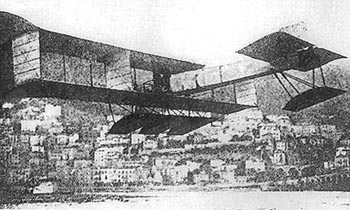
Voisin Hydro Canard 1(2?), 1912
http://w1.871.telia.com
Later models featured a fixed stabilizer with separate elevators. This assembly was of broader chord than the earlier all flying elevator. A plane of this configuration which took part in the 1912 Monaco sea plane meeting, again piloted by Colliex, is shown above. Note also that it has four floats instead of the usual three. A similar looking machine was bought by the French navy as their first aeroplane.
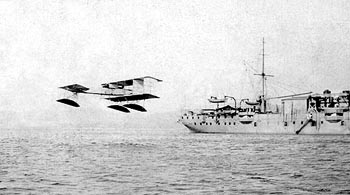
Voisin Hydro Canard 1/2? , c.1911/12
download a 1000pixel image
Voisin Hydravion
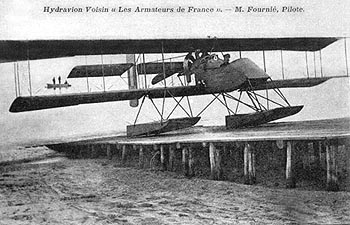
Voisin Hydravion, c.1913/14
http://members.home.net
Gabriel Voisin, 1880 - 1973
http://www.libraries.wright.edu
One of the greats of French aviation, Gabriel Voisin built his first airplane for Ferber in 1907. It was based on their loose understanding of the Wright brother's design which they had not yet seen. Voisin and Ferber hadn't yet grasped the Wright's innovative system of lateral control through wing warping, hence the vertical "curtains" between the wings, designed to counter roll and give the aircraft the stability of a box kite. The result flew but was next to impossible to turn.
Gabriel et Charles Voisin
http://perso.respublica.fr
L'ingènieur Gabriel Voisin (Belleville/Saùne 1880 Ozenay 1973) exploita, avec son frëre Charles (Lyon 1882 - Corcelles 1912), un atelier de mècanique Lyon. Ils s'intèressërent rapidement des prototypes de planeurs èquipès de moteurs explosion.
En 1905, ils expèrimentërent, sur la Seine, Paris, un appareil biplan destinè l'aviateur Blèriot. En 1907, les frëres Voisin s'installërent Billancourt et devinrent les premiers constructeurs d'avions. En 1908, un appareil Voisin rèalisa le premier kilomëtre en circuit fermè.
En 1912, Charles Voisin fut tuè dans un accident de voiture dans le Rhùne. L'entreprise des frëres Voisin connut malgrè cela une forte expansion, surtout pendant la Premiëre Guerre mondiale, avec la construction d'avions de reconnaissance et de bombardiers.
Gabriel Voisin mourut en 1973.
Gabriel et Charles Voisin
perso.club-internet.fr
Gabriel (1880-1974) et Charles (1882-1912)
Collection Roger-Viollet, photo H. Manuel
Nouvelle Histoire Mondiale de l'Aviation, Edmond Petit
Ils construisirent leur premier cerf-volant en 1898. Gabriel commença par expérimenter le planeur, pour le compte, entre autres, de Blériot.
A partir de 1902, il chercha à équiper les planeurs d'un moteur à explosion et exécuta des vols en traction sur la Seine à partir de 1905. L'année suivante, il expérimenta l'un des premiers modèles d'hydravion sur le lac d'Enghien (en fait, un biplan équipé de flotteurs).
Avec son frère Charles, à partir de 1905, il commença la production industrielle d'avions dans un atelier de Billancourt. Le 30 Mars 1907, Charles Voisin effectua son premier vol au-dessus du terrain de Bagatelle. C'est sur un des appareils produit par les deux frères que fut accompli le 13 Janvier 1908 le premier kilomètre parcouru en circuit fermé, aux mains d'Henri FARMAN.
Le 21 Mars 1908, le record fut porté à plus de deux kilomètres et, le 28 Mars, eut lieu le premiver vol d'un appareil avec passager (biplan Voisin, pilote Léon Delagrange et passager Henry Farman).
Le 30 Octobre eut lieu le premier trajet entre deux villes, à savoir Bouy et Reims, soit la distance de 27 kilomètres qui furent franchis en 20 minutes.
Charles Voisin se tua en 1912, dans un accident automobile. A partir de 1918, Gabriel Voisin se détourna de l'aviation pour se consacrer à la construction automobile, domaine dans lequel il fut le premier à introduire les notions d'aérodynamisme.
L'Histoire des frères Voisin
http://www.chez.com
1893
Charles et Gabriel après avoir lu quelques livres vantant les mérites de la marine, décident de s'engager dans la marine espagnole. Il partent et finirent leur périple au bout de 3 jours à Valence (Drôme).
1894
Leurs constructions commence par un vélo.
1895
Construction d'un fusil à partir des documents concernant le fusil Lebel. Au cours des essais leur fut alertée par le bruit et leur confisquât celui-ci. Deux jours plus tard il fut échangé par un vulgaire tube en acier pour rejoindre ses anciens propriétaires.
C'est au cours de cette même année que leur grand-père les guida dans la construction de cerfs-volants classiques. Mais cela n'est suffisant et ils construisent un petit modèle de machine à vapeur.
Gabriel intègre l'école des Beaux Arts de Lyon et il travaille en dehors des cours chez M Péguin qui habite rue Constantine. Il trace des plans et effectue des dépôts de brevets. Il travaille par la suite chez M Burel, architecte, rue Lanterne.
1897
Ils déménagent de la rue Paul Bert pour habiter dans un bâtiment appartenant à son grand-père au 62 cours Gambetta.
1898
Il quitte Lyon pour aller à Paris. En octobre, il rencontre une demoiselle, Angeline, qui le gratifia de 2 indispositions qu'il eu du mal à soigner.
Les quartiers d'été de la famille changent suite à l'acquisition d'une maison à Genay. Les frères réquisitionnent le hangar pour en faire leur atelier. Ils décident alors de construire un bateau à voile mais le bois leur faisant défaut, ils décident de la faire en fer blanc. Celui-ci fut 'récupéré' dans l'usine à gaz toute proche. Le bateau ne put naviguer correctement qu'après l'intervention de M Wilbert (ingénieur) dont les conseils devaient porter leurs fruits dans les futurs constructions Voisin. Leurs bateau leur permis de visite tous les îlots de la Saône.
1899
Ils vendent la maison de Genay après l'achat d'une maison à Villevert Neuville sur la rive droite de la Saône. Les dons d'une tante, leur permis d'acheter une forge, une enclume, un établi, 3 étaux, une machine à percer et tout le nécessaire pour souder, braser et ajuster. Un ébéniste habitant à quelques pas de la maison mis à disposition des jeunes Voisin, sa scie à ruban. La maison de Villevert contenant une barque en acajou. Ils décident de la transformer en bateau en vapeur. La chaudière en mauvaise état fut récupérée dans l'usine à gaz puis restaurée. Le nom de cet esquif fut : le Pyroscaphe.
Les travaux de Hargrave leur arrivent par les journaux et ils décident de construire un cerf-volant cellulaire. En quelques heures, Gabriel, construit son premier Hargrave et 15 jours plus tard, avec son frère, ils en construisent un autre de 2 mètres de coté. Celui-ci à leur grande surprise, fut capable de soulever un poids d'une douzaine de kilo alors que le vent du midi était moyen. C'est Charles qui propose de construire un nouveau Hargrave de 5 mètres. Il s'écrasa lors de son premier vol après 3 semaines de travail.
Le problème semblant venir du poids de l'engin ils remplacent le bois par du bambou. Remplacement qui fut un succès.
Remarque importante : à cette époque les travaux d'Ader et de Lilienthal leurs sont inconnus.
Un jour qu'ils effectuaient des essais sur un de leur Hargrave (capable de soulever 12 kg) ils furent surprit par la pluie qui mouillât les toiles. Immédiatement, celles-ci se tendent permettant de soulever Gabriel. Quelques jours plus tard, ils tentaient à nouveau de soulever Gabriel mais le cerf-volant refusa de l'élever. Charles couru chercher de l'eau, arrosât la cellule et celle-ci les souleva alors avec une extrême facilité. De ce jour, ils vont badigeonner leurs machine avec de la colle de pâte. Ceci resta sur leurs avions de 1904 à 1910 pour être finalement remplacer par de l'acétate de cellulose.
A cette même époque, Gabriel acheta un tricycle à pétrole. Leurs essais purent alors être fait plus loin et ils arrivèrent en haut d'une carrière à Couzon. Cette carrière de 70 mètre de haut aurait été une belle piste de lancement mais aucun des deux frère n'osa sauter pour tester les qualités de leur cerf-volant.
Gabriel décide aussi de construire sa propre voiture. Celle-ci lui demanda 3 mois de travaux.
Paris
Il quitte Neuville pour Paris où il entre aux Beaux Arts dans la section Architecture. Charles intëgre l'école d'hydrographie de Boulogne. Gabriel rencontre Angèle qui le quitte à cause d'un départ rapide pour Neuville, puis il rencontre Georgette. Sa situation se dégrada et au cours d'un voyage à Neuville, Georgette mourut d'une péritonite.
Il travailla comme dessinateur dans les travaux de l'exposition universelle de 1900. Au cours de ses travaux, il découvre l'avion d'Ader. Il rencontre alors Espinoza qui était le contremaótre d'Ader. Celui-ci lui raconte toute l'histoire de l'avion d'Ader. Quelques temps après il rencontre Ader. Plusieurs rencontres permirent aux deux hommes d'échanger sur l'aéronautique et la tactique aérienne.
1900
Les essais que firent les 2 frères, permis de comprendre l'importance du centre de gravité sur l'équilibre en vol de leurs machines. Ainsi, dès le mois de mai, il trace son premier projet de machine volante et décide de ne pas poursuivre ses études entraónant Charles dans cette aventure. Leur oncle mis très tôt finà cette idée.
1901
Le 5 février 1901, jour se majorité Gabriel récupère l'héritage de son grand-père soit 50 000 frs or (soit plusieurs millions actuels). Fin février il tente une tournée en temps qu'acteur dans une troupe de thè,tre de troisième zone. Dès le printemps il est de retour à Villevert où il construit un voilier de 7 mètres (baptisé Marsa) avec l'aide de son frère.
Au cours d'une régate sur la Saùne, il rencontre Marie une jeune blonde de 17 ans. Il est alors appelé à Montélimar au 52ième régiment d'infanterie. Il est "dispensé" et fait son service en 10 mois au lieu de 36.
1902
En mars, Charles qui habite alors à Toulon est accusé du meurtre de son amie, mais un vrai miracle le sauve car le vrai meurtrier fut arrÍtè pour une autre affaire et passa aux aveux. De retour à Villevert, ils se lancent dans la construction d'une seconde voiture. Celle-ci fut un èchec. Le 29 novembre Charles est rappelé au 89ième régime d'infanterie de Lyon où il reste 9 mois.
A 23 ans, il découvre les travaux de Chanute (mentor des frères Wright) et réalise un planeur sur ce modèle. Celui-ci est moins stable que leur planeur Hargrave mais s'envol plus facilement. Il démonte les 2 planeurs et réalise un assemblage Chanute avant, Hargrave arrière.
C'est avec cette engin, que Charles effectue le premier vol officieux le 26 mars 1906 et officiel le 13 janvier 1908 piloté par Farman. Pour finir c'est cet avion qui effectua le premier vol de ville à ville lui aussi piloté par Farman.
Par l'intermédiaire de son ami Claudius Genevrier il rencontre le colonel Renard et son frère. Le colonel avait démontré le rôle du centrage, découvert et codifié le rôle des empennages et déterminer les formes et les conditions d'utilisation des hélices aériennes.
Les deux frères facilitent l'accès de Gabriel à leur atelier en lui permettant d'accroître ses connaissances aéronautiques.
1903 - 1904
Archdeacon fait construire à Chalais Meudonun planeur sur le modèle de Chanute. le colonel Renard remet à Gabriel un mot d'introduction auprès d'Archdeacon mais celui-ci ne perçues pas les capacités de Gabriel. C'est grâce à un coup du hasard que tout se débloque. Archdeacon allait sortir avec sa Renault qui a avait quelques ratés par temps froid. il est dit que le problème et Gabrielle qui passait. Celui-ci, en quelques minutes, résout le problème en faisant une déviation du pot vers le carburateur qui givrait. cela décida Archdeacon de confier son planeur à son Sauveur. les essais du planeur furent prévus à Berck sur Mer.
C'est le jour de Pâques 1904 qu'ils eurent lieu devant un parterre de commanditaires. Au bout d'une heure les vols duraient 10 à 25 secondes.
Gabriel propose par la suite de construire un planeur tracté de façon à déterminer la puissance motrice nécessaire à un avion. Archdeacon hésite et crée le syndicat d'aviation avec Messieurs Loyal, Maas et Vogüé. Gabriel est nommé ingénieur et sa paye s'élève à 190 francs par mois.
Dans le même temps Henri de la Meurthe crée le prix pour le premier vol pour un montant de 25.000 francs suivie pour la même somme par Archdeacon.
En juillet 1904 il s'installe avec Genevrier dans un hôtel particulier de Montmartre. Mais une querelle entre l'ami de Claudius et les deux hommes, mis fin cette cohabitation et Gabriel à ménage passage Dantzig au mois de janvier 1905.
1905 - 1906
Avril, montage de la première cellule équipée d'un moteur à 2 hélices. Celui-ci ne fonctionnera que dans l'atelier.
de Gabrielle intègrent à l'atelier de Monsieur Surcouf à Billancourt. Ces essais nécessitant beaucoup de place, il demanda à Archdeacon une autorisation d'utiliser le terrain militaire d'Issy-les-Moulineaux chose faite en quelques jours. le 26 mars 1905, il tenta un vol tracté mais Archdeacon demande à Gabriel de faire un premier et c'est avec sacs de sable à la place du pilote. Ceci sauva la vie à Gabriel car l'avion s'écrasa. Archdeacon décide alors que les essais tractés se feront sur la Seine. ce n'est qu'en juin 1905 qu'un essai fut tenté entre le pont de Billancourt et le pont de Sèvres.
Le bateau utilisé pour la traction était "La Rapière" un bateau de course de 150 chevaux (Panhard). cet essai concluant permis au planeur de voler à 16 ou 20 m de haut sur une distance de 600 m. La puissance utilisées pour ce vol fut de 28 chevaux. Louis Blériot qui a assisté à ce vol commande immédiatement modèle identique. Deux mois plus tard 2 machines étaient construites. Une pour le syndicat de l'aviation équipée d'un indicateur de vitesse et la machine destinée à Blériot.
La première vola 100 m et la seconde terminait son vol dans l'eau après 30 m. 3 jours après ces vols, Blériot propose une association Gabriel. Gabriel quitta le syndicat, il rachète les ateliers de Surcouf, rue de la Ferme, et voici l'apparition des ateliers "Blériot - Voisin".
Tout commença pour le mieux, avec la rencontre de Madame Blériot et les travaux, mais Gabriel découvrit trop tard le côté bourru de Blériot. après de nombreuses divergences techniques et plusieurs échecs, Gabriel rachète Blériot ses parts dans la société qui devient "les frères voisins".
Cette société comptait 2 ouvriers : Métayer et Brost tout de menuisiers. L'atelier allait fermé mais Monsieur Florencie demanda de construire un avion à ailes battantes mais cet échec technique renfloua les caisses. Léon Delagrange passe commande fin décembre 1906 pour un avion dont il paya un quart à la commande et le solde après un vol exécuté sous ses yeux sans incident.
1907
Fin février, la commande de Delagrange est prête. Ils achètent une voiturette utilisée comme tracteur et le 20 février tout et prêt. à 13 heures la tentative débute mais l'avion se brisa en vol. Le dimanche suivant, l'appareil se brisa de nouveau. Les parties très fragiles furent renforcés et le 30 mars 1907 à Bagatelle, un vol de 80 m à 5 m de hauteur fut réussi. Le pilote était Charles Voisin. Delagrange paya séance tenante. Henri Deutch de la Meurthe commande un dirigeable à Surcouf dont la cellule fut construite par les Frères Voisin.
de votre commande en arrivèrent :
Un hollandais, Monsieur Reissner, pour la construction avion de son invention.
Un russe, le prince Smemiky, pour un avion de son invention.
Puis en mai 1907, un sportif accompli du nom d'Henri Farman passa. Le 1er juin 1907 il passa commande d'un avion Voisin muni d'un moteur Antoinette de cinquante chevaux payable après la réussite d'un vol de 1 km. Livraison fut faite en août 1907.
Au 31 décembre 1907 le record de distance est de 771 m pour Henri Farman sur Voisin.
1908
Tous les vols jusqu'à ce 13 janvier 1908, s'étaient effectués en ligne droite, donc bien loin de l'idée que l'on se fait de l'aviation. C'est Henri Farman, à bord d'un Voisin, qui est le premier à tenter une boucle avec un avion. En effet, le gros problème de l'époque est celui du maintient de l'avion lors d'un virage sa faible vitesse l'entraînant dans une position où la résistance à l'air devenait trop importante.
C'est sur le terrain d'Issy-les-Moulineaux, que les commissaires préparent la tentative.
Ils comptent la distance à l'aide d'une bicyclette dont ils comptent les tours de roue. A bord de son Voisin propulsé par un moteur Antoinette et une hélice en acier, Henri Farman décolle et survole la ligne de départ. Il vole à une altitude de 7 m, exécute un virage parfait autour du pylône, survole une nouvelle fois la ligne et réussit un atterrissage impeccable. Son vol d'une durée de 1 minute 28 secondes, sur une distance de 1 300 m à une vitesse de 50 km/h est le premier vol de l'histoire de l'aviation.
Ce record, permis à Farman de gagner le prix d'Ernest Archdeacon et Henri Deutsch de la Meurthe qui récompense le premier pilote qui parvenait à effectuer un vol soutenu d'un kilomètre en circuit fermé. Ce prix fondé en 1904 était d'un montant de 50 000 frs or.
1909
Les avions Voisin participent à la Grande Semaine d'aviation à Reims. Ils se classent dans les différentes catégories mais ne gagnent que le Prix des mécaniciens.
1914
Le 14 août 1914, bombardement de l'usine de Zeppelins de Metz-Frescaty par 2 avions Voisin pilotés par le lieutenant Antoine Cesari et la caporal René Prudhommeau. Chaque avion a largué un obus de 155 mm.
Le 29 novembre 1914 arrivée d'un groupe de bombardement à Nancy. Ce groupe est équipé d'avions Voisin III pouvant transporter 450 kg de charge pour une vitesse de 110 km/h.
1915
Le quartier général Français demande à Gabriel de construire un prototype d'une très grosse machine de bombardement. 35 jours plus tard, le triplan quadrimoteur de 1800 CV de 40 mètres d'envergure décollait du terrain d'Issy les Moulineaux. Le pilote était Frantz.
1916
Le 28 février 1916, sept bombardiers Voisin partis de Salonique bombardent la ville de Smyrne en Turquie.
Gabriel Voisin par Lartigue
http://www.lartigue.org
In 1904, aged 13? (to be researched Ed.), Jacques Henri Lartigue began accompanying his brother Maurice, another flying fanatic, to Issy-les-Moulineaux, eager for new experiences.
At the time, this town on the southern edge of Paris had a hug military parade ground, "a vast and empty expanse of packed earth," that could be used by the aeronauts whose craft were now equipped with motors and propellers.
Jacques witnessed the test flights, the speed and distance records but also the accidents. He became an informed observer of this modern spectacle, and soon a specialist.
Between 1904 and 1914 Jacques Lartigue (b:Courbevoie, June 13, 1894 - Nice, d:September 12, 1986), took hundreds of photos of this flying strip with its hangars, aircraft and curious onlookers. These were this young photographer's first published images.
Lartigue photographed, drew and described the exploits of each plane. And most of all, he came to know his new heroes, the "aviators." Gabriel Voisin, the pioneer ...who gave up architectural studies to devote himself to making "flying machines".
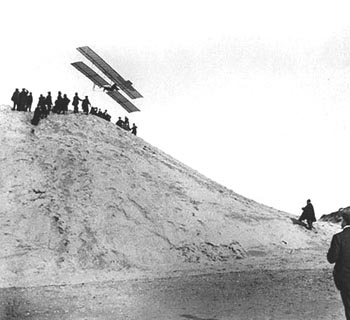
'The First Flight of Gabriel Voisin'
Gabriel Voisin, Archdeacon Glider, Berck Beach, Pas-de-Calais, France, 1904
© Photograph by Jacques Henri Lartigue, aged 10 years
http://www.lartigue.org
On 3 April 1904, he took to the air on Berck Beach in his Archdéacon craft. Gabriel and his brother Charles were the first people in France to build planes on an industrial scale.
Reference: Pierre Borhan & Martine d'Astier, Les Envols de Jacques Henri Lartigue, Paris: Editions Philippe Sers, 1989.
Note : This summer (year?) the municipal museum of Berck (Pas-de-Calais, France) is publishing a book entitled Berck retrouvé : le temps des photographes which features a number of photographs by Jacques Henri Lartigue as well as an excerpt from his diary in which he describes his first experiences of the new world of aviation. For it was on the beach here that the young Lartigue, camera at the ready, witnessed the first flight of Gabriel Voisin on board his plane Archdéacon, in April 1904. The young boy was fascinated by this new world of discoveries and feats.
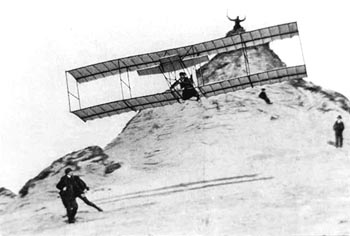
Gabriel Voisin, Archdeacon Glider
Berck Beach, Pas-de-Calais, France, 1904
Photograph possibly by Jacques Henri Lartigue, aged 10 years
download a 750pixel image
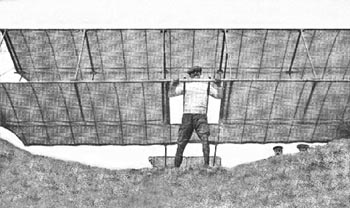
Charles Voisin, le Touquet, 1907
Images in the following section have yet to be fully researched and the information posted may be subject to error. Your eMail comments on these and any other image captions indeed anything on the page, are most welcome
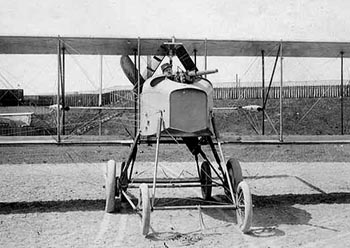
Voisin Type ?, 'Avion Cannon', 37mm cannon
download a 750pixel image
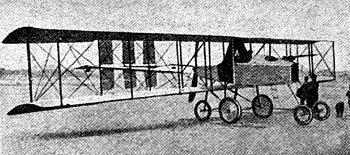
Voisin Type ?, 'Avion Cannon', 37mm cannon
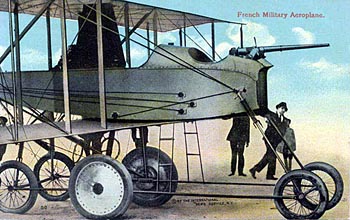
Voisin Type ?, 'Avion Cannon', 37mm cannon
download a 1000pixel of this image
Books to research
Pierre Borhan & Martine d'Astier, Les Envols de Jacques Henri Lartigue, Paris: Editions Philippe Sers, 1989.
Berck retrouvé : le temps des photographes
Top | Pioneers Home
| 
